Bring Ideas to the Table with a Conversation Potluck
As I've prepared this summer for another year of directing a Classical Conversations challenge program, I have really loved contemplating the idea of our Challenge community days involving a feast of ideas to discuss. As tutors and students prepare the work, it is similar to them preparing for a lovely dinner party to enjoy together.
However, sometimes this dinner party ends up half-baked, under cooked, and missing items. Since our society at large is generally unpracticed at participating in collaborative conversations, it is no wonder that it takes time for our students to warm up to chewing on big ideas together. But they can, and they do, and it's why I keep coming back to direct year after year. The feast is worth it.
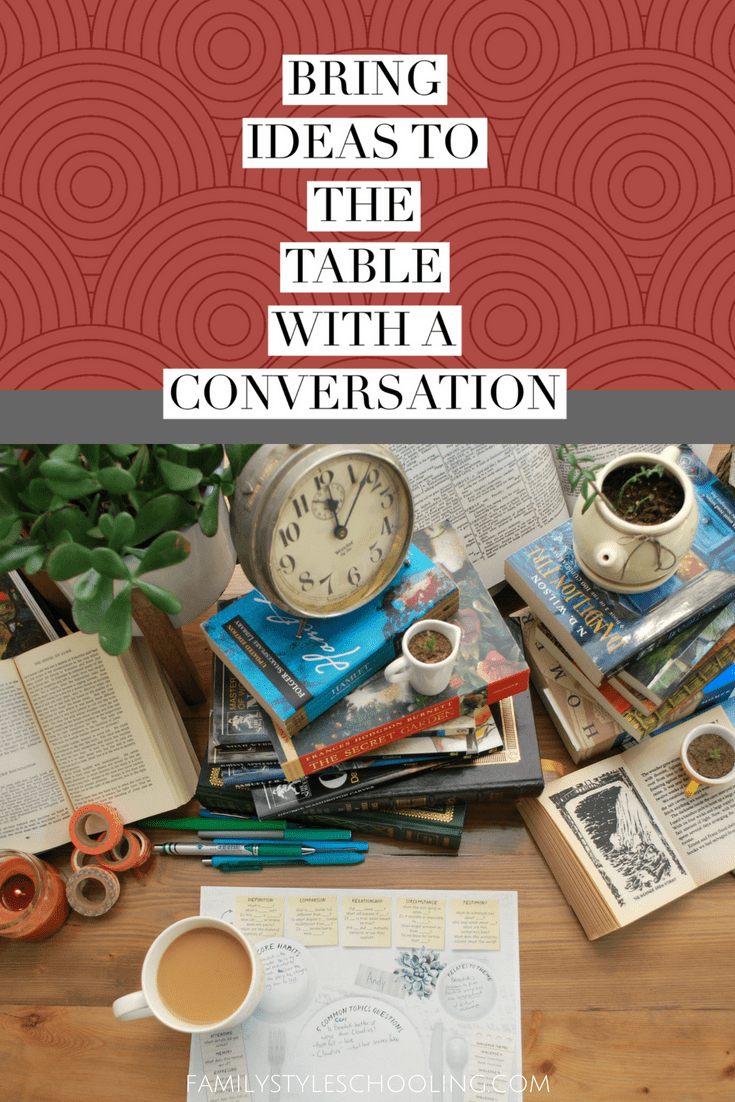
This year I've created a fun "table setting" to welcome students to the conversation and encourage confidence in asking good questions and thinking together. It's a free 8.5 x 11 download, or as a placemat (11 x 17) so I hope you try it out with your family or your Challenge students! Enjoy!
Start with What Interests Students
The table is set, yet where do you even start a conversation on a book that you've all read (at least most of)? My desire for this Conversation Place Setting is to give my students a couple of minutes before we start our discussion to jot down a question or two in each of the three dishes. Then when we go to start our discussion, I can ask students what interested them about the book to help draw them in to a discussion.
When I was in high school, I dreaded tests on novels I read. It isn't that I didn't read the books, or didn't enjoy them, it was simply that the details that my teacher chose to highlight on the test may or may not have been details that stood out to me. When you're working with standardized forms of assessment, you have to come up with some way to test students, but I didn't enjoy feeling like the parts of the book that interested me were wrong.
If I find something interesting, I most often have something to say about it. That's why when I meet someone new, I always start off with questions about themselves to get them talking. This is usually a great way to get a conversation started because people generally love talking about themselves, or at least what interests them. In the same way, I want to talk about what stood out to the students, because that will generate more ideas to chew on together.
What If Nothing Interested Them?
Oh I love when a student comes to class and says they hated a book because it was boring. I've come to realize that when they say that it's more a case of not understanding than not feeling like the message the author was trying to convey was worth their time. In that case you go back to the beginning, and simply discuss observations. I love the 5 Core Habits for this reason. They reorient dialectic students to the basics that they might have overlooked in their haste to get to the good stuff.
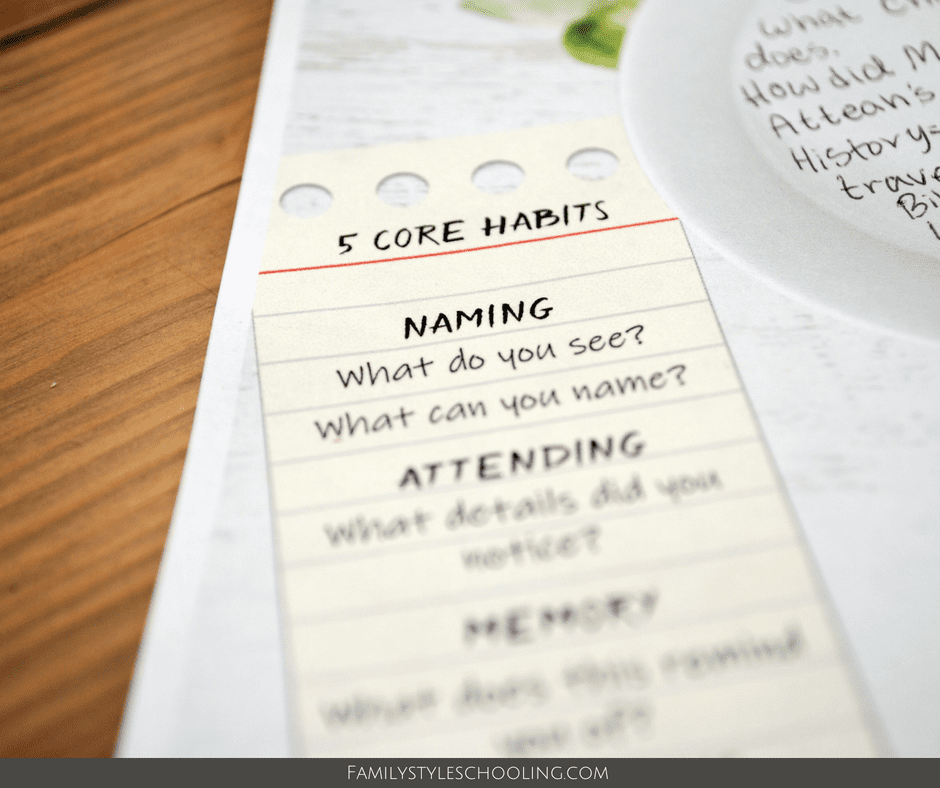
The 5 Core Habits are a tool introduced by Classical Conversations to Foundations students, and include:
- Naming
- Attending
- Memorizing
- Expressing
- Storytelling
5 Core Habits As An Appetizer
Well, again, think of a meal. What is the purpose of an appetizer? It's to set the mood and get you excited about what's coming next. Sometimes we jump so quickly into the main course that our guests aren't ready to eat what main dish we're serving.

Here are some examples of questions they could write down for the first book of each Challenge level in that first dish:
- Challenge A: In The Lion, the Witch, and the Wardrobe you could name the children in the story, the animals they meet, known associates of the White Witch. You could attend to the details of the weather throughout the story, the locations of the battles, or the gifts given by Father Christmas. Students could use their memory of the book to recount how the kids found their way to Narnia, how Aslan saved Edmund, or how Aslan ultimately defeated the White Witch. They could express where they saw math, history, science, Latin, or geography in the story. Finally, they could use storytelling to share with the class or a friend what this story told them about God.
- Challenge B: For Phantom Tollbooth students could name the places Milo travels, the characters he meets, or the skills Milo needed to get home. You really can't appreciate this book if you don't attend to the double meanings of the words that Norton Juster plays with throughout the adventure. From memory, students could tell about how Milo conducts a symphony of color, escapes the Island of Conclusions, and frees Rhyme and Reason. They could express where they saw math, history, science, Latin, or literature in the story. Finally, they could use storytelling to share with the class or a friend what this story told them about God.
- Challenge I: If you're discussing The Sign of the Beaver students could name the supplies Matt is left with, the chores he must complete to stay alive, or the characters he meets while he's alone in the woods. They could attend to the way Matt teaches English to Attean, how Attean teaches Matt to recognize the signs in the forest, and the craftsmanship of the items Matt makes in preparation of his family's return. From memory, students could tell about how Matt's gun is stolen, how he is saved by Attean and his Grandfather, or how he's welcomed into the Indian community. They could express where they saw history, bias, worldview, or science in the story. Finally, they could use storytelling to share with the class or a friend what this story told them about God.

- Challenge II: As you dive into discussing Beowulf, students could name characters of the story, myths referenced, feats of Beowulf. They could attend to the feasts in the castle, the value systems expressed, and the characteristics of the monsters. Students could use their memory of the book to recount how the story begins, how Beowulf gets connected with the King and his quest, or Beowulf's battle with Grendel. They could express where they saw history, Latin, geography, philosophy, or worldview in the story. Finally, they could use storytelling to share with the class or a friend what this story told them about God.
- Challenge III: For Shakespeare's Much Ado About Nothing, you could name the characters, love triangles, or gossip. Students could attend to how deception is used by different characters, expressions of honor, or demonstrations of public shaming. In light of the mood of the play, students could recall from memory the masquerade ball, the courtship of Beatrice, and the songs interspersed throughout the play. They could express where they saw reasoning, history, worldview, or bias in the story. Finally, they could use storytelling to share with the class or a friend what this story told them about God.

- Challenge IV: As you discuss Hesiod's Theogony you could name the gods and godesses, attend to the relationships and genealogy of each. They could recall from memory where they've heard these tales referenced in their other reading. They could express where they saw reasoning, history, worldview, or bias in the story. Finally, they could use storytelling to share with the class or a friend what this story told them about God.
You can see that although the questions are very repetitive, they could unlock some excellent foundational elements of each story that will open up great conversations with the 5 Common Topics.
Questions That Produce Meaty Conversations
The 5 Common Topics are tools for generating ideas. Utilizing the simple questions that accompany each topic can keep a conversation going in such a way that souls are nourished with deep and meaningful or meaty conversations.
When students bring up the questions, they're getting to the heart of the story at the same time as they're getting to the heart of what interested them about the story. This really goes a long way towards helping students desire to eat the meal that's being served. They don't need to come up with thousands of questions, just one or two that interest them.

The 5 Common Topics include:
- Definition
- Comparison
- Relationship
- Circumstance
- Testimony
Curious people use these questions fairly naturally, but sometimes you need reminders as to what kinds of questions you can even ask to discover good open ended questions that foster conversation.
Here are some examples of questions they could write down for the first book of each Challenge level in that main dish:
- Challenge A: In The Lion, the Witch, and the Wardrobe you could define a witch, magic, or a sacrifice. Students could compare Edmund and Lucy, the White Witch and Aslan, or winter and spring. You could discuss the relationship between Edmund's betrayal and Aslan's death. For circumstance you could look at what was going on at the same time Father Christmas was giving out gifts. Finally, you could ask what testimony could Mr. Tumnus give about the White Witch.
- Challenge B: For Phantom Tollbooth students could define the essential qualities of an education. They could compare asking the question: is the Island of Conclusions better or worse than The Silent Valley? You could discuss the relationship of numbers and letters. Are they mutually exclusive or can they coexist? In circumstance you could discuss whether it's certain that Tock is Milo's friend. For testimony, you could see if you could discover Norton Juster's bias throughout the story.
- Challenge I: If you're discussing The Sign of the Beaver students can define what Matt is not. They can compare Matt's way of life to Attean's. They can look at the relationship of the very real problem of what might happen if Matt's family never returns. They can discuss the circumstances surrounding Matt's attempt to get honey. Finally, they could seek the testimony of Attean's grandmother about the character of Matt.

- Challenge II: As you dive into discussing Beowulf, students could define what a hero is. They could compare Hrothgar and Beowulf. For relationship you could ask if Beowulf caused Grendel's mother's wrath. In circumstance students could discuss what might prevent Beowulf from living happily ever after. Finally, you could discuss the testimony of Beowulf's followers.
- Challenge III: For Shakespeare's Much Ado About Nothing, you could define love, "noting", or ado. In comparison one could ask whether Benedick is better or worse than Claudius. For relationship you could discuss what led to Hero faking her death. In circumstance you could ask if it is possible or impossible for Benedick to truly fall in love with Beatrice. Finally you could discuss what does Claudius, as an authority, assume about the world?
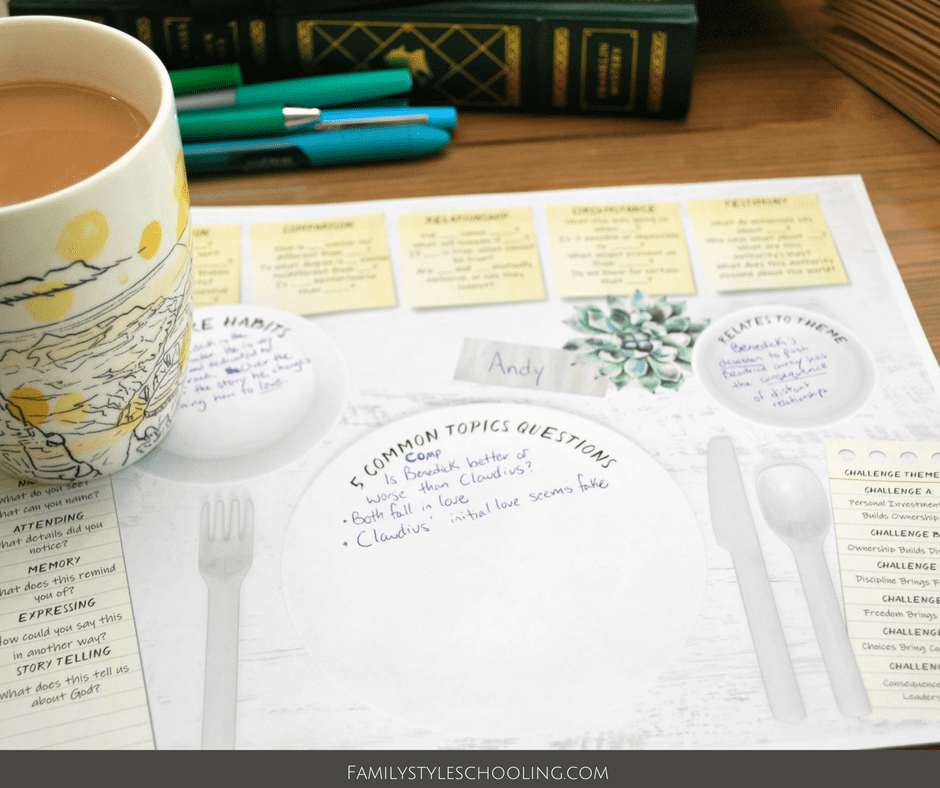
- Challenge IV: As you discuss Hesiod's Theogony you could define what the essential qualities are of a deity. For comparison you could discuss how Greek gods are similar to or different from Roman gods. In relationship you could discuss the progression of Zeus becoming the chief god. They can discuss the circumstances of the creation of the world according to Hesiod. Finally, you could ask how the testimony of the Apostle Paul in Acts reveals his understanding of the truth of these myths.
A feast of conversation is in store for those who desire to apply their curiosities to the books they are reading and enjoy the savory meal of cooperating with others in serving up this meal.
Digesting with Dessert
A fine dining experience, in my opinion, ends with just the right dessert...and possibly a cup of coffee. These meal closers give guests the opportunity to reflect on the meal, enjoy a sweet bite, and let their meal settle before leaving the table. Therefore, I've added one more item to my Conversation Place Setting: How what you're discussing relates to the themes of the Challenge programs.
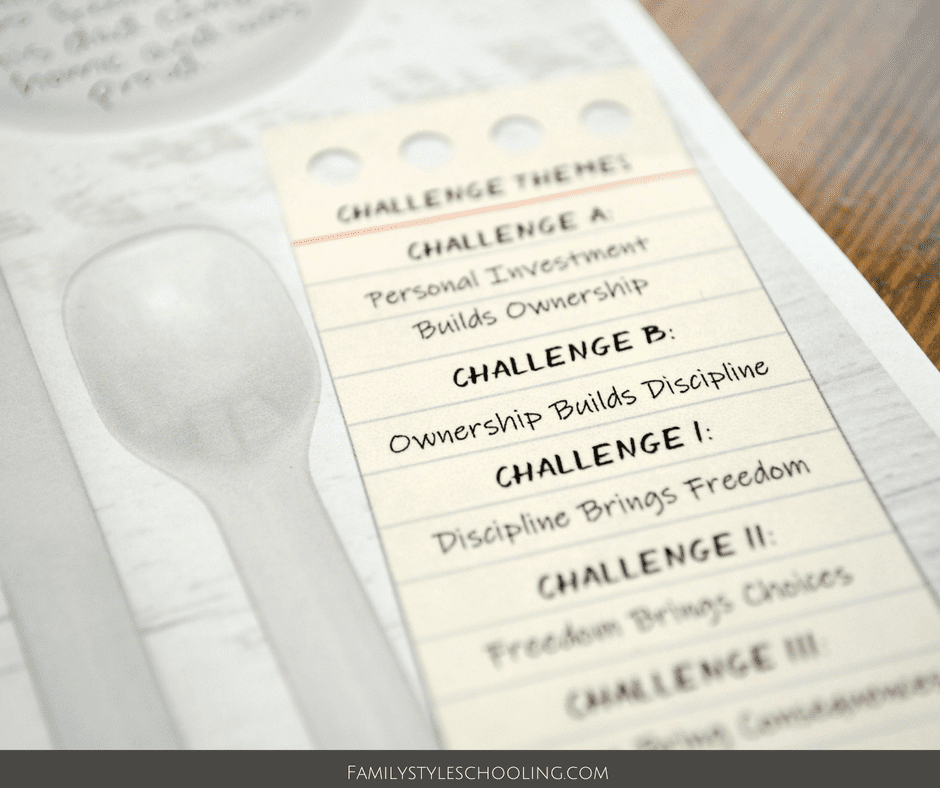
The Challenge program themes are one of the things that drew me to Classical Conversations in the first place. I loved the logical progression laid out for cultivating a leader. The themes are as follows:
- Challenge A: Personal Investment Builds Ownership
- Challenge B: Ownership Builds Discipline
- Challenge I: Discipline Brings Freedom
- Challenge II: Freedom Brings Choices
- Challenge III: Choices Bring Consequences
- Challenge IV: Consequences Birth Leadership
This is probably the easiest question to ask, but students can just jot down ideas where they notice the theme of their Challenge level represented in the material you're discussing. Going back to our stories, here are some suggestions of what students might write in that final dish on the right:
- Challenge A: In The Lion, the Witch, and the Wardrobe you could discuss where you see personal investment developing ownership in Edmund's life, Mr. Tumnas's life, or Aslan's life.
- Challenge B: For Phantom Tollbooth students could look at the discipline Milo expresses in rescuing Rhyme and Reason.
- Challenge I: If you're discussing The Sign of the Beaver students can discuss how Matt's discipline in taking care of the family house was freeing when his family finally arrived.

- Challenge II: As you dive into discussing Beowulf, students could discuss how his discipline as a fighter provides choices for the hero.
- Challenge III: For Shakespeare's Much Ado About Nothing, you can discover how the choices of the characters produce severe consequences for Hero and her family.
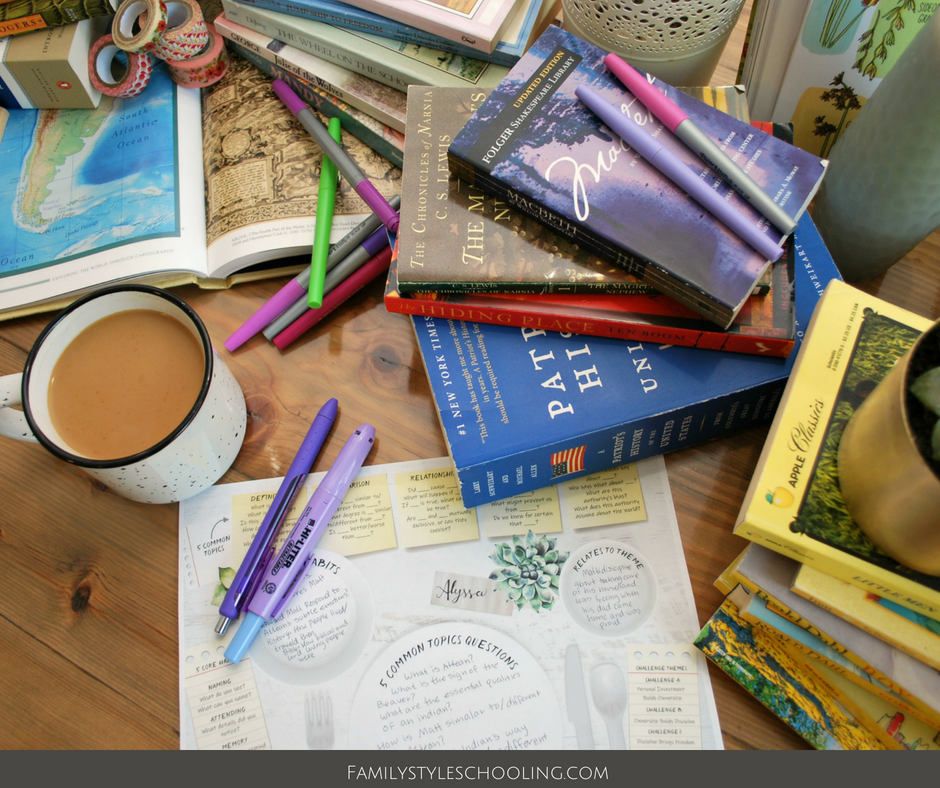
- Challenge IV: As you discuss Hesiod's Theogony you discuss how the consequences of all of the selfish choices the gods and goddesses make impact their leadership.
Messy Meals
Ultimately, these conversations are lovely but they are so messy! It is so wonderful when everyone brings ideas to the table though. It's those ideas that we come together in community to wrestle with. My desire is that this Conversation Place Setting can be a way to welcome friends into conversations that serve one another in love.
Hopefully when they get a taste of the goodness available, they will want to keep coming back for more.
Betsy Strauss is an unexpected homeschooler, mother of three, who is in a relationship with a sweet man for life. She loves reading books, drinking coffee, and learning anything with her kids.



Betsy, you hit this out of the park! This is a great integration of the tools we’ve been learning about and such a warm, hospitable invitation to conversation for all. Thank you for sharing your time, talents, and gifts! You enrich our community beautifully!
Thanks so much Christy! I tried it out on my book club with my community moms and we really had a great conversation. It was neat to see what they noticed in the book and how the conversation just kept flowing! They are such great tools, and I’m so thankful to be learning how to use them better!
Betsy,
In the Challenge classroom setting would you plan to have copies of this for students to work on during class to begin discussion or to have one copy for each student that is laminated that they use over and over again? I guess I’m wondering if they would need/want to keep what they wrote down and not erase it. Thoughts?
Thank you for sharing this. It is so pretty and simple!
Aimee
I’m thinking to just have a laminated copy. In Challenge I, I encourage them to bring something to take “notes” in, so maybe they can just write their best thoughts down in their notes to save, but feel the freedom to erase the questions they bring up that didn’t inspire deeper thoughts.
Betsy,
I LOVE all your thoughts and ideas. You truly are gifted. I have a technical question. How did you print this as a placemat? With CC I have an account with Office Max/Depot and when I download it to their site in a 11×17 format there is an extra white edge on either side of the mat? Curious how you made yours look so nice?
Thank you again for sharing!
Thanks,
Krista
Krista! I’m so excited that you’re enjoying this. I was just printing it as an 8.5×11…but I did go ahead and convert it to an 11×17 for you. You can download it here!
Beautiful. Excellent explanations for those new to this and wonderful reminders and encouragement to those who are returning to the Challenge Feast! Thank you for sharing your time, talent, and thoughts!
This is a wonderful idea! Thank you for sharing it with others! I like the idea of using this at home, as well with my different level Challenge kids. It is a good place to START the conversation at home. I love the idea of using it in class too. Thank you!!
Yes! Starting the conversation at home is so helpful in building the conversations in class. As a slow processor myself, if I enter a conversation and this is the first time I’ve thought of a concept, it’s really hard to contribute verbally even if my mind is tracking along! I love it when kids come to community talking about the conversations that they had at home on a topic. It really does raise the conversation to a new level.
Love this Betsy! You are one gifted momma:)
Thanks again for sharing your wonderful ideas and resources.
Lori
Thanks Lori! I’m happy to share them.
Betsy: Thank you for sharing this! I have some areas looking forward to Challenge, but with kiddos not yet old enough. I’m going to use this at a Moms Night Out to help start the discussion and help them see what to expect in the Challenge years.
Wonderful! I hope you have some great conversations! I used this in a book club with my group and we had some great questions to discuss. Most of the moms only had foundations kids, but they really got into it. Enjoy!
This is so so wonderful!! As a brand new (and apprehensive) Challenge A director, I am thrilled to have such an amazing resource to share with my new class… May God bless you for sharing such treasures with us.
Seeking Him always,
Karla
Huge “thank you!” coming from this new Ch 2 director! I just laminated these and am so excited to see how this aids our discussions!
Genius. Thank you for sharing this lovely tool!